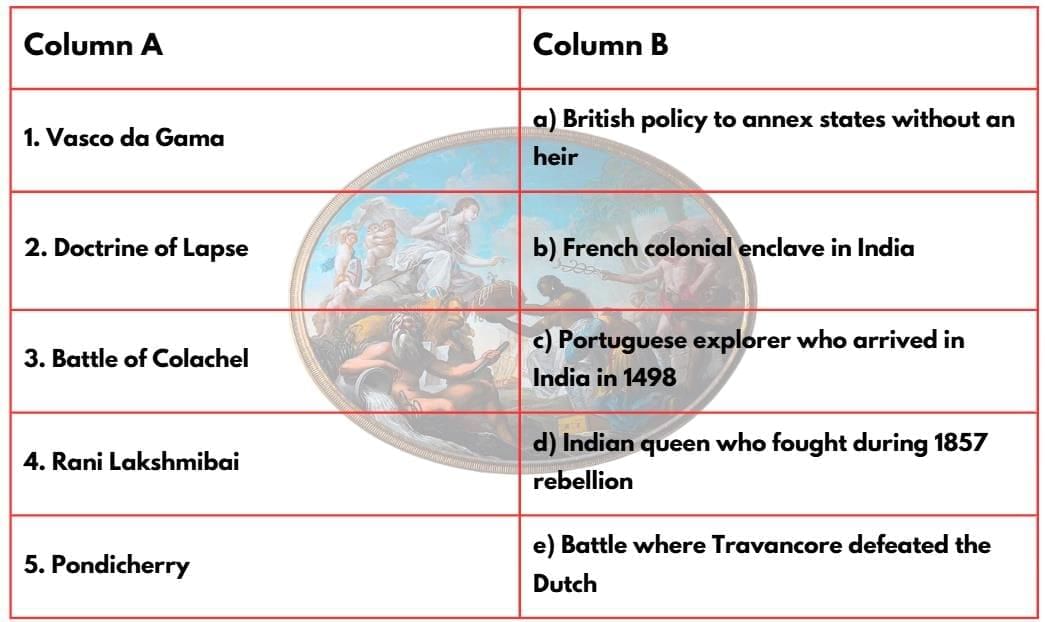Worksheet: The Colonial Era in India | Worksheets with Solutions for Class 8 PDF Download
| Table of contents |

|
| Multiple Choice Questions (MCQs) |

|
| Match the Following |

|
| True or False |

|
| Fill in the Blanks |

|
| Very Short Question Answers |

|
Multiple Choice Questions (MCQs)
Q1. What is colonialism?
(a) One country taking control of another, imposing political, economic, and cultural systems
(b) Trading goods between countries
(c) Forming alliances for protection
(d) Promoting local cultures
Q2. Which European explorer arrived in India in 1498, marking the start of European colonisation?
(a) Christopher Columbus
(b) Vasco da Gama
(c) Ferdinand Magellan
(d) Robert Clive
Q3. The Portuguese used which system to control trade in the Arabian Sea?
(a) Subsidiary Alliance
(b) Cartaz pass system
(c) Doctrine of Lapse
(d) Divide and Rule
Q4. Which Indian queen resisted Portuguese control in Ullal using alliances and fireballs made from coconut shells?
(a) Rani Lakshmibai
(b) Rani Abbakka
(c) Begum Hazrat Mahal
(d) Rani Durgavati
Q5. The Dutch lost control in India after which battle?
(a) Battle of Plassey
(b) Battle of Colachel
(c) Battle of Buxar
(d) Battle of Panipat
Q6. Which European power established a trading post in Pondicherry in 1674?
(a) Portuguese
(b) Dutch
(c) French
(d) British
Q7. What strategy did the British use to become rulers while pretending to be traders?
(a) Subsidiary Alliance
(b) Divide and Rule
(c) Cartaz system
(d) Assimilation policy
Q8. The Doctrine of Lapse allowed the British to annexe princely states on what condition?
(a) Ruler died without a natural male heir
(b) Ruler converted to Christianity
(c) The territory was conquered by the British army
(d) Ruler was voted out
Q9. What was one major cause of the Bengal Famine of 1770–72?
(a) Crop failure only
(b) British taxation demands during the famine
(c) War destruction
(d) Natural drought alone
Q10. Which Indian leader wrote about the drain of India’s wealth caused by British rule?
(a) Dadabhai Naoroji
(b) Jawaharlal Nehru
(c) Mahatma Gandhi
(d) Romesh Chunder Dutt
Match the Following

True or False
Q1. The British used a ‘divide and rule’ policy to control India.
Q2. The Portuguese Inquisition in Goa lasted until the early 19th century.
Q3. The French extensively interfered in Indian social and religious customs.
Q4. The Bengal Famine killed around 10 million people due to both crop failure and British policies.
Q5. The Battle of Plassey was won with the help of Mir Jafar’s betrayal of Nawab Siraj-ud-daulah.
Q6. The British Crown took over direct control of India from the East India Company after 1857.
Fill in the Blanks
Q1. Colonialism began in the __________ century with European expansion.
Q2. Vasco da Gama landed at __________ in India.
Q3. __________ was the colonial capital of Portuguese India.
Q4. The British used the __________ strategy to exploit rivalries among Indian rulers.
Q5. The __________ rebellion of 1857 is considered a major turning point in Indian resistance.
Q6. The __________ rebellion was led by ascetics opposing British tax policies.
Q7. The British education policy was shaped by Thomas __________.
Very Short Question Answers
Q1. What was the main goal of European colonialism?
Q2. Name the European powers that competed for control over India.
Q3. Who were Rani Abbakka I and II?
Q4. What was the significance of the Battle of Plassey?
Q5. Explain the Doctrine of Lapse briefly.
Q6. What caused the Bengal Famine of 1770 to become so deadly?
Q7. Name one way the British changed traditional Indian industries.
Q8. Who was Begum Hazrat Mahal, and what role did she play?
Q9. How did the British education policy divide Indian society?
Q10. What was one unintended positive consequence of colonial rule in India?
You can find Worksheet Solutions here: Worksheet Solutions: The Colonial Era in India
FAQs on Worksheet: The Colonial Era in India - Worksheets with Solutions for Class 8
| 1. What were the major reasons for the British colonization of India? |  |
| 2. What was the impact of the British rule on Indian society? |  |
| 3. Can you explain the significance of the Indian National Congress during the colonial era? |  |
| 4. What were some of the major revolts against British rule during the colonial era? |  |
| 5. How did the British economic policies affect Indian agriculture and industry? |  |




















